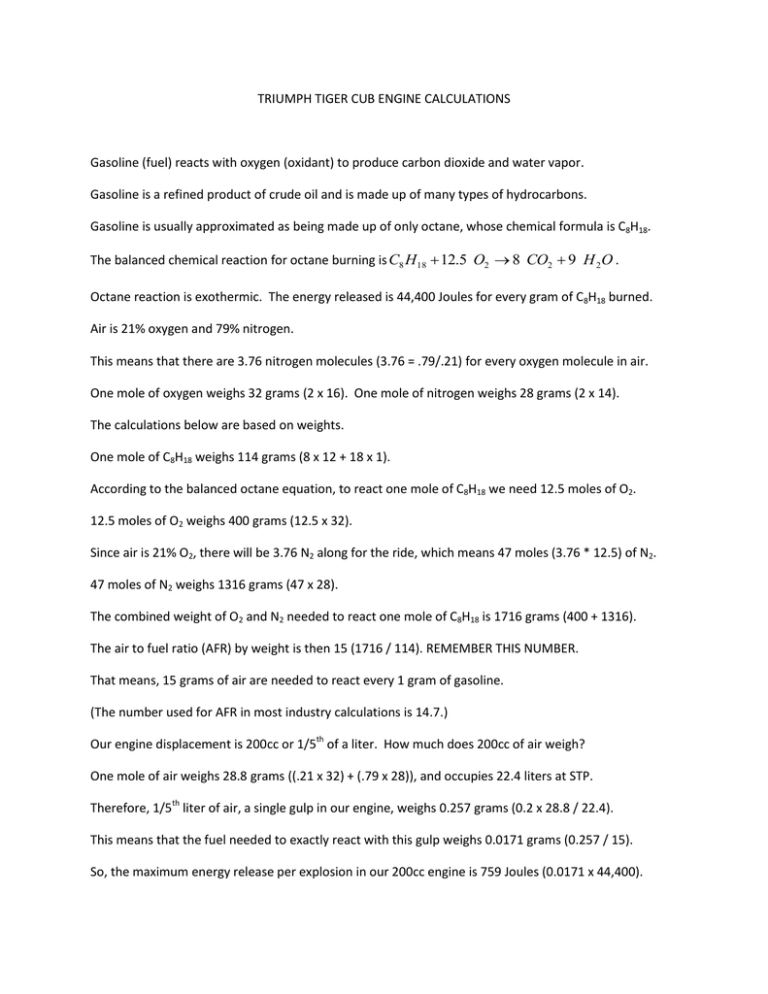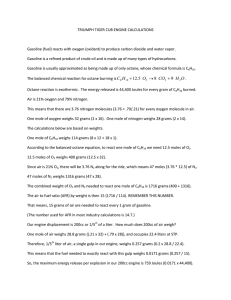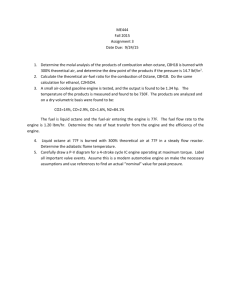OH CO O HC 9 8 5.12 + → +
advertisement

TRIUMPH TIGER CUB ENGINE CALCULATIONS Gasoline (fuel) reacts with oxygen (oxidant) to produce carbon dioxide and water vapor. Gasoline is a refined product of crude oil and is made up of many types of hydrocarbons. Gasoline is usually approximated as being made up of only octane, whose chemical formula is C8H18. The balanced chemical reaction for octane burning is C8 H18 12.5 O2 8 CO2 9 H 2 O . Octane reaction is exothermic. The energy released is 44,400 Joules for every gram of C8H18 burned. Air is 21% oxygen and 79% nitrogen. This means that there are 3.76 nitrogen molecules (3.76 = .79/.21) for every oxygen molecule in air. One mole of oxygen weighs 32 grams (2 x 16). One mole of nitrogen weighs 28 grams (2 x 14). The calculations below are based on weights. One mole of C8H18 weighs 114 grams (8 x 12 + 18 x 1). According to the balanced octane equation, to react one mole of C8H18 we need 12.5 moles of O2. 12.5 moles of O2 weighs 400 grams (12.5 x 32). Since air is 21% O2, there will be 3.76 N2 along for the ride, which means 47 moles (3.76 * 12.5) of N2. 47 moles of N2 weighs 1316 grams (47 x 28). The combined weight of O2 and N2 needed to react one mole of C8H18 is 1716 grams (400 + 1316). The air to fuel ratio (AFR) by weight is then 15 (1716 / 114). REMEMBER THIS NUMBER. That means, 15 grams of air are needed to react every 1 gram of gasoline. (The number used for AFR in most industry calculations is 14.7.) Our engine displacement is 200cc or 1/5th of a liter. How much does 200cc of air weigh? One mole of air weighs 28.8 grams ((.21 x 32) + (.79 x 28)), and occupies 22.4 liters at STP. Therefore, 1/5th liter of air, a single gulp in our engine, weighs 0.257 grams (0.2 x 28.8 / 22.4). This means that the fuel needed to exactly react with this gulp weighs 0.0171 grams (0.257 / 15). So, the maximum energy release per explosion in our 200cc engine is 759 Joules (0.0171 x 44,400). (Recall that octane has an energy content of 44,400 Joules / gram -- see above) Less fuel (lean mixture) will give less energy per explosion and result in air in the exhaust. More fuel (rich mixture) will not completely react and cause unburned hydrocarbons in exhaust. The top speed of the engine is 6000 RPM (revolutions per minute) or 100 RPS (revolutions per second). There is one explosion for every two crankshaft revolutions – recall that we have a 4-stroke engine. Thus, at top engine speed, there are 50 explosions per second. The power is the energy per time. This results in 37,950 Watts (759 Joules x 50 per second). Note that a Watt is a Joule / second, and one horsepower (Hp) is 746 Watt. Thus, the engine Hp at 100% efficiency is 50.9 Hp (37,950 / 746). The manufacturer spec is about 14 Hp. The engine efficiency is 27% (14 / 50.9). This is typical of most gasoline engines - almost 1/3rd efficient. Where does the 200cc come from? The cylinder diameter is 6.3 cm. The piston stroke is 6.4 cm. The piston area is r2 and r = 3.15 cm. The piston area is 31.2 cm2. The volume is area x length. So the displacement volume is 31.2 x 6.4 = 200 cm3 or 200cc. How can we get more energy per explosion? More displacement – bigger engine Higher starting pressure in cylinder – supercharge using air compressor on intake Use pure oxygen instead of air Use a fuel with more energy per reaction – liquid hydrogen yields about 142,000 Joules / gram. Use a fuel that includes oxygen in molecule – nitromethane, a racing fuel, is CH3NO2. (“Gasoline is for washing parts, Alcohol is for drinking, nitro is for racing.”) How can we get more power out of the engine? More energy per explosion More explosions per time


